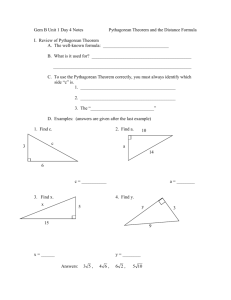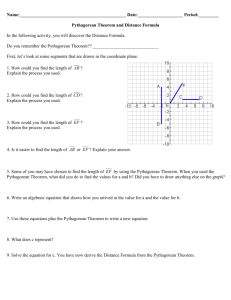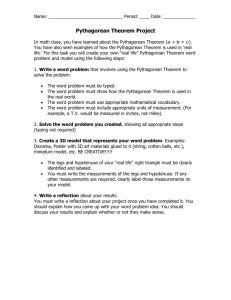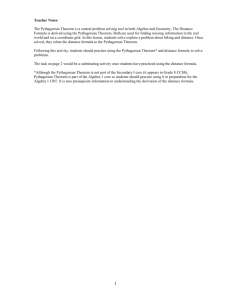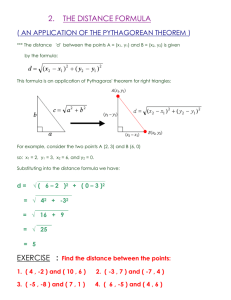Pythagorean Theorem Word Problems
advertisement
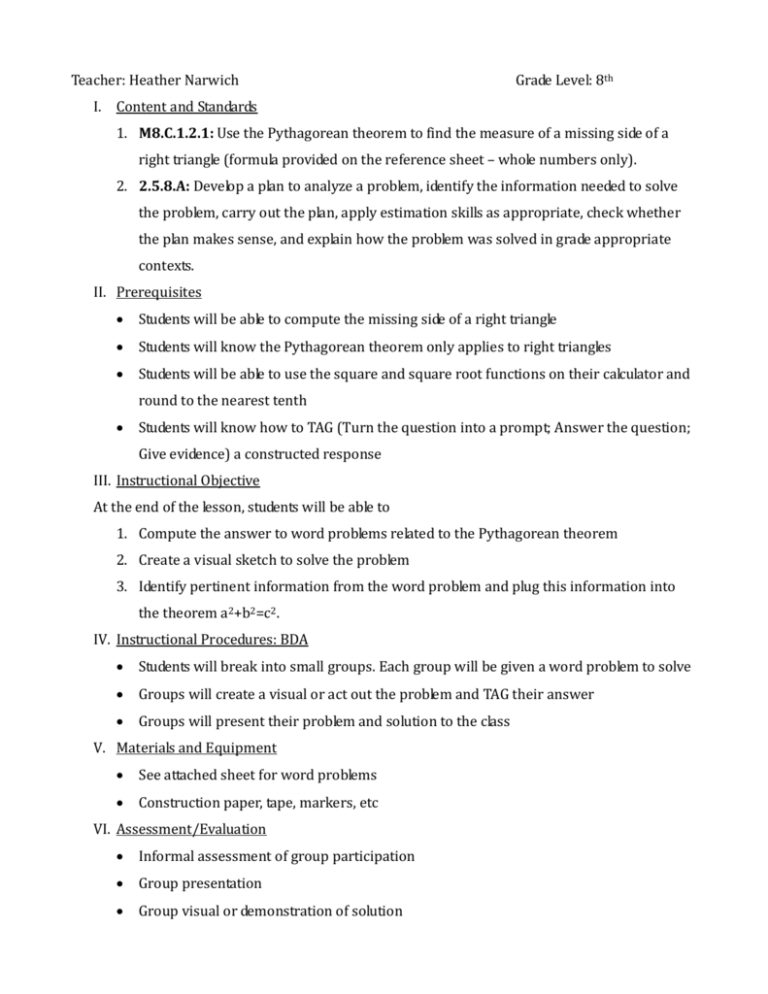
Teacher: Heather Narwich Grade Level: 8th I. Content and Standards 1. M8.C.1.2.1: Use the Pythagorean theorem to find the measure of a missing side of a right triangle (formula provided on the reference sheet – whole numbers only). 2. 2.5.8.A: Develop a plan to analyze a problem, identify the information needed to solve the problem, carry out the plan, apply estimation skills as appropriate, check whether the plan makes sense, and explain how the problem was solved in grade appropriate contexts. II. Prerequisites Students will be able to compute the missing side of a right triangle Students will know the Pythagorean theorem only applies to right triangles Students will be able to use the square and square root functions on their calculator and round to the nearest tenth Students will know how to TAG (Turn the question into a prompt; Answer the question; Give evidence) a constructed response III. Instructional Objective At the end of the lesson, students will be able to 1. Compute the answer to word problems related to the Pythagorean theorem 2. Create a visual sketch to solve the problem 3. Identify pertinent information from the word problem and plug this information into the theorem a2+b2=c2. IV. Instructional Procedures: BDA Students will break into small groups. Each group will be given a word problem to solve Groups will create a visual or act out the problem and TAG their answer Groups will present their problem and solution to the class V. Materials and Equipment See attached sheet for word problems Construction paper, tape, markers, etc VI. Assessment/Evaluation Informal assessment of group participation Group presentation Group visual or demonstration of solution VII. Accommodations or Modifications I have an “easy” problem with whole numbers in case an IEP student is really struggling, but I am hoping they can contribute to their group problem VIII. Technology The Smart board will be used to give instructions and students can use it to illustrate their solution IX. Self-Assessment I will use student feedback to tweak my word problems. 1. The slide at the playground has a height of 6 feet. The base of the slide measured on the ground is 8 feet. What is the length of the sliding board? 2. The bottom of a 13-foot straight ladder is set into the ground 5 feet away from a wall. When the top of the ladder is leaned against the wall, what is the distance above the ground it will reach? 3. In shop class, you make a table. The sides of the table measure 36" and 18". If the diagonal of the table measures 43", is the table “square”? (In construction, the term "square” just means the table has right angles at the corners.) 4. In the Old West, settlers made tents out of a piece of cloth thrown over a clothesline and then secured to the ground with stakes forming an isosceles triangle. How long would the cloth have to be so that the opening of the tent was 6 feet high and 8 feet wide? 5. A baseball “diamond” is actually a square with sides of 90 feet. If a runner tries to steal second base, how far must the catcher, at home plate, throw to get the runner “out”? Given this information, explain why runners more often try to steal second base than third. 6. Your family wants to purchase a new laptop with a 17” widescreen. Since the 17 inches represents the diagonal measurement of the screen (upper corner to lower corner), you want to find out the actual dimensions of the laptop. When you measured the laptop at the store, the height was 10 inches, but you don’t remember the width. Calculate and describe how you could figure out the width of the laptop to the nearest tenth inch. 7. During a football play, DeSean Jackson runs a straight route 40 yards up the sideline before turning around and catching a pass thrown by Michael Vick. On the opposing team, a defender who started 20 yards across the field from Jackson saw the play setup and ran a slant towards Jackson. What was the distance the defender had to run to get to the spot where Jackson caught the ball? 8. In construction, floor space must be planned for staircases. If the vertical distance between the first and second floors is 3.6 meters, and a contractor is using the standard step pattern of 28 cm wide for 18 cm high, then how many steps are needed to get from the first to the second floor and how much linear distance (ie “width” or “base”) will be needed for the staircase? What is the length of the railing that would be attached to these stairs?

